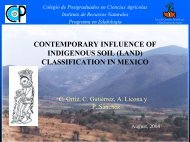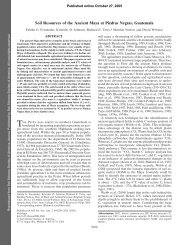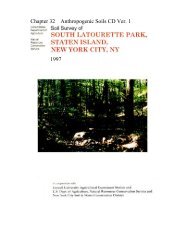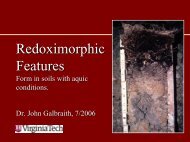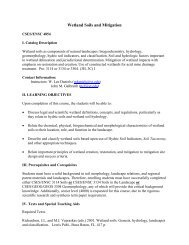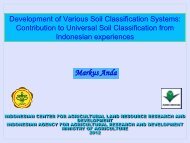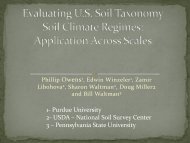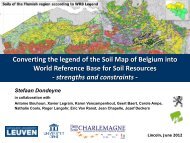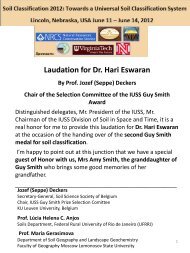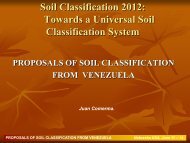Nebraska Soils Field Trip - Virginia Tech
Nebraska Soils Field Trip - Virginia Tech
Nebraska Soils Field Trip - Virginia Tech
Create successful ePaper yourself
Turn your PDF publications into a flip-book with our unique Google optimized e-Paper software.
4th IUSS Soil Classification Conference <strong>Field</strong> Tour Guidebook<br />
Mean annual precipitation--66 to 81 centimeters (26 to 32 inches)<br />
Frost-free period--145 to 175 days<br />
GEOGRAPHICALLY ASSOCIATED SOILS: These are the Dow, Ida, Napier, and Steinauer<br />
soils.<br />
Dow--are at lower elevations on side slopes, have carbonates within a depth of 25 centimeters<br />
(10 inches), and have a matrix chroma of 2 in the lower two thirds of the series control section<br />
Ida--are at lower elevations on side slopes, have carbonates within a depth of 25 centimeters (10<br />
inches), and have a matrix chroma greater than 2 in the lower two thirds of the series control<br />
section<br />
Napier--are at lower elevations on base slopes and have a mollic epipedon 61 to 102 centimeters<br />
(24 to 40 inches) thick<br />
Steinauer--are at lower elevations on side slopes, have carbonates within a depth of 25<br />
centimeters (10 inches), and have a sand content of 20 to 52 percent in the particle-size control<br />
section<br />
DRAINAGE AND PERMEABILITY:<br />
Drainage class--well drained--saturation does not occur within a depth of 1.8 meters (6 feet)<br />
during the wettest periods of most years<br />
Saturated hydraulic conductivity--moderately high<br />
Surface runoff potential--negligible to high<br />
USE AND VEGETATION:<br />
Most areas are cultivated. Some steeply sloping areas are forested or pastured. The principal<br />
crops are corn, soybeans, small grains, and hay. The native vegetation is big bluestem, little<br />
bluestem, indiangrass, switchgrass, and other grasses of the tall grass prairie.<br />
DISTRIBUTION AND EXTENT:<br />
Physiographic Division--Interior Plains<br />
Physiographic Province--Central Lowland<br />
Physiographic section--Dissected till plains<br />
MLRAs--<strong>Nebraska</strong> and Kansas Loess-Drift Hills (106) and Iowa and Missouri Deep Loess Hills<br />
(107)<br />
LRR M; western Iowa, northeastern Kansas, eastern <strong>Nebraska</strong>, and possibly northwestern<br />
Missouri along the Missouri River<br />
Extent--large<br />
MLRA SOIL SURVEY REGIONAL OFFICE (MO) RESPONSIBLE: St. Paul, Minnesota<br />
SERIES ESTABLISHED: Monona County, Iowa, 1957.<br />
REMARKS:<br />
Particle-size control section--the zone from a depth of 25 to 100 centimeters (10 to 40 inches)<br />
(A, Bw1, Bw2, and C horizons);<br />
series control section--the zone from the surface to a depth of 150 centimeters (0 to 60 inches)<br />
(Ap, A, Bw1, Bw2, and C horizons).<br />
98





